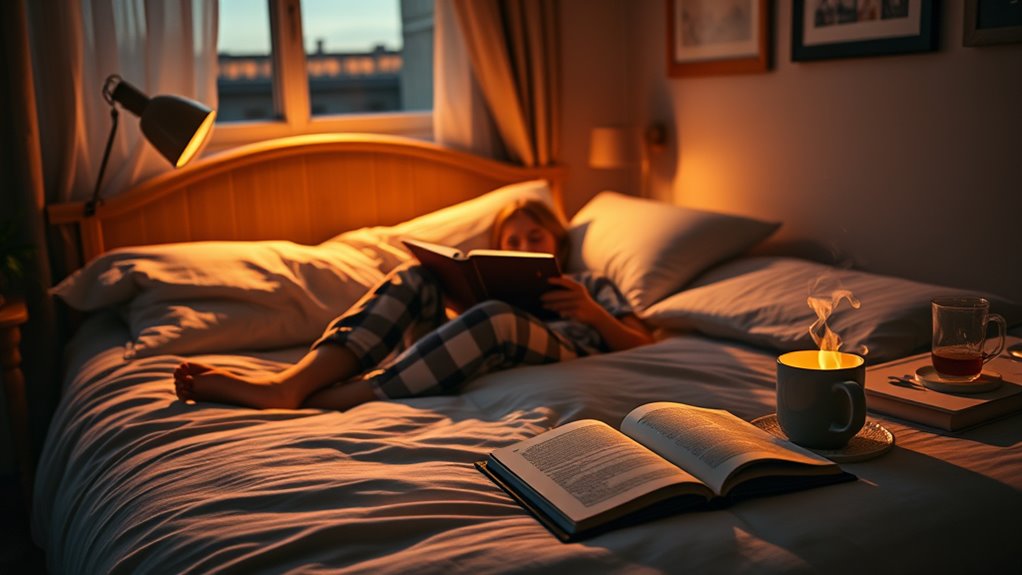I Built a Bedtime Routine That Actually Works for Me
Have you ever noticed how a simple bedtime routine can transform your sleep quality? You’re likely juggling habits that disrupt your rest, but aligning with your natural rhythms—through consistent schedules and screen-free evenings—makes a real difference. Now, consider how these tweaks could work for you too.
Key Takeaways
- Track your nightly habits for a week to identify and eliminate sleep-disrupting patterns.
- Set a fixed bedtime and wake-up time to regulate your circadian rhythm and improve sleep quality.
- Incorporate relaxing music or nature sounds into your routine to reduce anxiety and promote unwinding.
- Limit screen time after 8 PM to minimize blue light and support melatonin production.
- Choose nutrient-rich foods like nuts and avoid evening caffeine to enhance rest and overall well-being.
The Journey to Finding My Ideal Bedtime
Have you ever struggled to pinpoint a bedtime routine that truly rejuvenates you? You’re not alone; research shows that a realistic bedtime routine boosts sleep quality by aligning with your natural rhythms.
Start by evaluating your daily schedule—experts recommend winding down an hour before bed with activities like reading or light stretching, based on studies from the National Sleep Foundation.
Make it practical: choose habits that fit your lifestyle, avoiding screens to reduce blue light exposure. This evidence-based approach helps you craft a routine that’s sustainable and effective, leading to better rest and energy.
To maximize benefits, consider building a bedtime stress relief ritual that includes personalized elements for unwinding.
Evaluating My Previous Habits
You assess your old bedtime habits to identify what’s truly effective and what’s holding you back.
Once you spot the flaws in your routine, such as inconsistent timings or distractions, you gain clear insights for improvement.
This practical evaluation, supported by sleep research, sets the foundation for a more reliable routine.
By incorporating bedtime wellness habits, you can enhance your sleep quality and overall well-being as part of a restful nightly routine.
Assessing Old Habits
Before diving into a new bedtime routine, evaluating your old habits provides a clear foundation for change.
First, track your nightly patterns for a week using a simple journal; note wake times, screen use, and sleep quality to gather data. This evidence-based approach, supported by sleep studies, reveals what’s effective or draining your energy.
You identify triggers like caffeine intake that disrupt rest, then prioritize positives to build on. Actively reflect on how these habits align with your goals, making informed tweaks for better outcomes.
Spotting Routine Flaws
Once you’ve tracked your nightly habits, spotting routine flaws means examining patterns that undermine your sleep, like inconsistent bedtimes or late-night screens. This involves reviewing your log for triggers such as late caffeine or stimulating activities, which studies show disrupt melatonin and extend sleep latency. By analyzing data, you’ll detect issues like irregular wake times or poor wind-down routines, backed by sleep research from the National Sleep Foundation. Here’s a table to guide you:
| Common Flaw | Evidence-Based Impact |
|---|---|
| Inconsistent bedtimes | Disrupts circadian rhythm |
| Late-night screens | Suppresses melatonin production |
| Caffeine after noon | Increases arousal and delays onset |
| Irregular meals | Affects blood sugar and restlessness |
| Stressful evening tasks | Elevates cortisol, reducing deep sleep |
Addressing these flaws empowers you to build a solid routine. (99 words)
Establishing a Fixed Schedule
To build a solid bedtime routine, you set a fixed bedtime hour that aligns with your body’s natural rhythms, backed by research showing consistent schedules enhance sleep quality.
Next, you establish a reliable wake-up time each day to reinforce this pattern and prevent sleep debt accumulation.
Together, these steps create a predictable routine that empowers you to feel more rested and alert.
By replacing evening screen time with calming activities, you can further improve your sleep and overall well-being.
Set Bedtime Hour
Establishing a fixed bedtime hour anchors your daily routine, ensuring consistent sleep patterns that research links to better health outcomes.
To determine yours, assess your sleep needs—aim for 7-9 hours as per expert guidelines—and pick a realistic time that aligns with your energy levels.
You’ll build reliability by treating it as non-negotiable; studies from the American Academy of Sleep Medicine show this regularity boosts immune function and mental clarity.
Use simple tools like alarms to reinforce the habit, avoiding late-night disruptions and fostering a stronger body clock for long-term vitality.
Establish Wake-Up Time
Just as fixing your bedtime anchors your routine, setting a consistent wake-up time completes the schedule and enhances your body’s natural rhythm.
Evidence from the National Sleep Foundation shows that a fixed wake-up time stabilizes your circadian rhythm, reducing insomnia risk and boosting daytime energy.
Choose a time allowing 7-9 hours of sleep, set a reliable alarm, and rise promptly to avoid grogginess.
Expose yourself to morning light to suppress melatonin and signal wakefulness.
Maintain this daily, even on weekends, to prevent social jetlag and improve focus, as studies confirm it enhances overall health and productivity.
Key Elements of My Daily Wind-Down
While many people underestimate a structured wind-down, you’ll enhance your sleep by focusing on these key elements.
Studies confirm that consistency in timing regulates your circadian rhythm, so set a fixed bedtime to signal rest.
Prepare your sleep environment by dimming lights and maintaining a cool room, which reduces alertness as per sleep research.
Avoid caffeine and heavy meals hours before bed to prevent disruptions.
Include a brief mental unwind, like reflection, to ease into sleep.
Track your routine’s effectiveness with a simple log, allowing data-driven adjustments for better results.
This approach builds lasting habits.
Embracing a soothing nighttime routine can significantly improve your overall sleep quality.
Relaxing Activities I Swear By
You know that building a solid bedtime routine includes activities like an evening reading ritual, which research shows can lower stress in just minutes. This simple habit lets you escape daily worries and prepare your mind for rest. Pair it with a soothing music playlist, as studies confirm that gentle tunes help regulate your heart rate and ease you into deeper sleep. Embracing calming night habits has been key to developing a routine that fosters long-term relaxation and rejuvenation.
Evening Reading Ritual
As the day draws to a close, incorporating an evening reading ritual into your routine offers a science-backed method to unwind and boost sleep quality.
Research from the University of Sussex shows reading reduces stress by up to 68% in just six minutes, activating your parasympathetic nervous system for relaxation.
Choose a physical book over screens to avoid blue light interference; it promotes melatonin production. Set aside 20-30 minutes before bed—select light fiction or poetry that engages without exciting you.
You’ll find this habit improves focus and deepens sleep, making mornings easier. Stick with it consistently for best results.
Soothing Music Playlist
Incorporating a soothing music playlist into your bedtime routine delivers proven relaxation benefits, as research from the Journal of Music Therapy indicates it cuts stress levels by up to 65% through rhythmic breathing and cortisol reduction. You can curate your own playlist by selecting tracks that promote calm; start with soft instrumentals or nature sounds for optimal results. Here’s a quick guide to get you started:
| Music Type | Key Benefits |
|---|---|
| Classical | Enhances focus and reduces anxiety |
| Nature Sounds | Boosts deep relaxation quickly |
| Ambient Tunes | Improves overall sleep quality |
This evidence-based approach helps you unwind effectively, making your routine more reliable.
Managing Technology in the Evenings
When evening sets in, limiting screen time becomes essential for better sleep, as research shows that blue light from devices suppresses melatonin production.
You can start by setting a strict cutoff, like 8 PM, to avoid late-night scrolling, which disrupts your circadian rhythm.
Use built-in features like Night Mode on your phone to filter blue light, backed by studies from the National Sleep Foundation.
Actively track your habits with apps that enforce breaks, helping you unwind naturally.
This evidence-based approach boosts sleep quality, making your evenings more restorative and productive.
Don’t ignore these simple tweaks—they work.
Beyond managing screens, engaging in my stress relief routine can help you recharge effectively.
Diet Choices That Support Better Rest
Diet plays a key role in optimizing your sleep, with research showing that specific foods can either promote or hinder melatonin production.
Choose nutrient-rich options like tart cherries or kiwis, which studies link to improved sleep quality by naturally boosting melatonin levels. Include magnesium-packed nuts and seeds to relax muscles and ease restlessness.
Steer clear of caffeine and spicy foods in the evening, as they interfere with your body’s wind-down process. For practical results, aim for a light dinner with tryptophan sources like turkey or bananas, enhancing your rest without overwhelming your system.
By incorporating these dietary choices into your routine, you can also boost immunity through improved nutrition and overall health support.
Strategies for Staying Consistent
While building a solid bedtime routine, you’ll find that consistency is key to reaping long-term benefits, as studies show it regulates your body’s internal clock and improves sleep quality over time. By adopting a consistent night routine, you can experience a transformative impact that helps you wake up feeling rejuvenated. To maintain it, set a fixed schedule, use reminders, track progress, and build habits gradually—backed by research from the Sleep Foundation.
| Strategy | Benefits | How to Implement |
|---|---|---|
| Fixed Schedule | Stabilizes circadian rhythm | Set bedtime and wake-up alarms |
| Reminders | Reduces forgetfulness | Use apps like Habitica |
| Progress Tracking | Enhances motivation via data | Log sleep in a journal daily |
| Habit Building | Creates autopilot routines | Pair with daily activities |
Stick to these strategies for lasting results.
Fine-Tuning Based on What Works
Once you’ve built a consistent bedtime routine, you can refine it by evaluating what truly boosts your sleep quality.
Track your sleep with a journal or app to identify effective elements, like dimming lights or warm baths, backed by research showing they reduce cortisol levels.
If an activity falls flat—say, reading feels energizing instead of soothing—swap it for alternatives, such as deep breathing, which evidence links to faster sleep onset.
Actively test changes over a week, measuring improvements in wakefulness and mood, to create a personalized routine that maximizes rest without unnecessary extras.
Incorporating insights from a transformative nightly ritual can further enhance your sleep by promoting overall wellness as supported by sleep experts.
Results and Ongoing Maintenance
After you’ve fine-tuned your bedtime routine, you’ll quickly see tangible results, such as deeper sleep and better daytime focus, as studies confirm that consistent practices reduce sleep latency by up to 50%.
To sustain these improvements, track your progress weekly using sleep apps, which provide data-backed insights into your patterns. Research indicates that regular monitoring enhances adherence, preventing relapses.
Adjust routines based on feedback—say, if wakefulness increases, tweak wind-down activities. Stay committed by setting non-negotiable cues, like dimming lights, ensuring long-term benefits like reduced stress and improved cognitive function.
Drawing from my experience, incorporating essential steps tailored to your lifestyle can make the routine even more effective.





